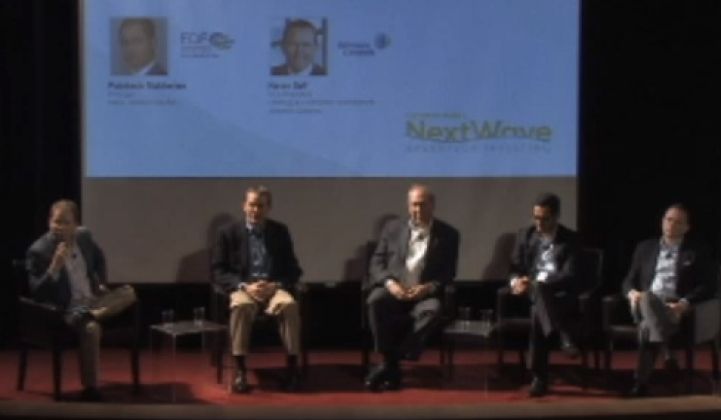Andrew Shapiro, founder of Broadscale Group, moderated a panel at Greentech Media's sold-out NextWave Greentech Investing event. He suggested that now is the time for corporate VC investors to confront the cleantech sector.
"Large corporates need to innovate to survive," said Shapiro, "They need to find new ways to develop products, solutions, business models. And they are increasingly recognizing that simply relying on their own R&D, their own business units isn't going to get them there. They are too big, too insular, too slow, and they need to look outside at open innovation...and partnerships and startups to do that."
Shapiro noted an upcoming article in the Harvard Business Review that finds that "startups that went public after being funded by at least one corporate venture capital investor outperformed those funded exclusively by independent financial VCs."
Case closed.
Shapiro pointed out that Elon Musk attributes some of Tesla's success to early strategic partnerships with Daimler, Panasonic, and Toyota.
Todd Dauphinais, Partner, Aster Capital Partners spoke of Aster's "very unique three-LP model." Power sector companies Schneider, Alstom, and Solvay are the LPs which provide the "deep domain expertise" for this fund with $200 million under management. Dauphinais said that 41 percent of cleantech deals have a corporate investor -- up from 22 percent a few years ago.
Kevin Self, Vice President, Strategy & Corporate Development, Johnson Controls noted that building efficiency is a $10 billion business within the $42 billion Johnson Controls. He emphasized Shapiro's point that "we need greater, better, and more focused R&D." Johnson Controls recently invested in Optimum Energy through Navitas.
Pulakesh Mukherjee, principal at BASF Venture Capital, spoke of BASF's $100 million fund "which operates [both] as a fund" and a separate legal entity. He said that the venture arm looks for companies working in areas where BASF is not currently innovating. Mukherjee said that if the goals of the company are not aligned with the corporates and the other institutional VCs, it will be difficult for that company to succeed.
Mark Platshon, a partner at Birchmere Ventures and senior advisor to BMW i-Ventures, contrasted BASF's process to that of BMW. He said that BMW built a "venture group at the brand level to create an infrastructure" around the recently introduced i3. The idea is to build an entire "ecosystem around charging, mapping, multi-modal transit, car-to-car communications, car-to-infrastructure communications and a whole bunch of other environmental ecosystem stuff around the electric vehicle and the future of transportation." He added that "the real markets are the megacities" where new types of transit are happening.
Platshon said that BMW is willing to say, "we'll disrupt our own world," adding "I'm pretty bullish on corporate VC when it's managed right. [...] When companies or corporates confuse business development with venture -- that's fraught with peril." He noted that "the horsepower these kinds of big companies can bring to bear can be phenomenal if it's managed right."
Platshon told a cautionary tale. "In an earlier life, I was one of the founders and the CEO of a company that pioneered online digital photography. [...] We met with Dan Carp, the CEO of Kodak, and told him, "You're in deep doggie doo-doo here. You need to be investing in this kind of stuff, building this kind of kind of stuff." Carp said that he would "never let digital take over weddings and medical."
He continued: "We said, 'You know, you don't have a choice. It's going there. You don't have a choice.'"
Platshon noted that BMW is "being disrupted by Tesla, no question." He added that BMW is also being driven by Tesla -- noting that a significant proportion of the $2 billion of Tesla's revenue would be BMW's.
As for why now is a good time for corporates to consider innovating in technology investments, Platshon told what he called "a tipping-point story."
"The gas ones were really good -- everybody had the gas ones. There was a whole gas infrastructure that really worked well. The electric ones that were coming along weren't very good. They didn't last very long, they didn't work very well, they weren't very reliable -- so the big companies stayed working with the gas ones.
"But there were a lot of entrepreneurs, a lot of universities, a lot of little companies, and some big companies that kept banging away on materials science trying to improve the electric ones so they could get up to where they could compete with the gas ones, and eventually -- it took many years, it actually took twenty years to have the 'a-ha' on materials so that the electric ones could actually compete head-to-head with the gas ones."
Platshon asked, "How long did it take for the gas ones to disappear and the electric ones to take virtually 100 percent market share? First, what am I taking about and when did it happen?"
"It took less than a decade for gas[-powered] lights to disappear, for a huge infrastructure to be completely ripped out and an entirely new infrastructure installed."
"The story doesn't need a lot of words changed to be applied to cars."
Watch the session here:



